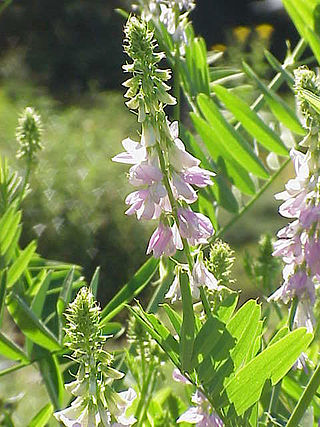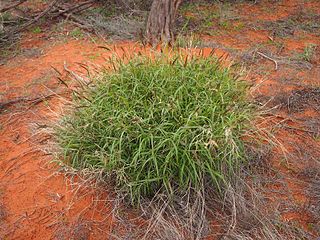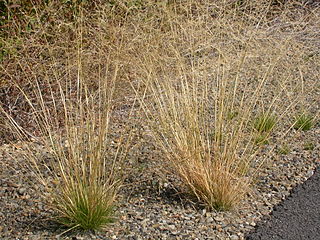
Alopecurus pratensis, known as the meadow foxtail or the field meadow foxtail, is a perennial grass belonging to the grass family (Poaceae). It is native to Europe and Asia.

Echium plantagineum, commonly known as purple viper's-bugloss or Patterson's curse, is a species of the genus Echium native to western and southern Europe, northern Africa, and southwestern Asia. It has also been introduced to Australia, South Africa, and United States, where it is an invasive weed. Due to a high concentration of pyrrolizidine alkaloids, it is poisonous to grazing livestock, especially those with simple digestive systems, such as horses.

Galega officinalis, commonly known as galega or goat's-rue, is a herbaceous plant in the subfamily Faboideae of the legume family Fabaceae. It is native to parts of northern Africa, western Asia and Europe, but is widely cultivated and naturalised elsewhere. The plant has been extensively cultivated as a forage crop, an ornamental, a bee plant, and as green manure.

Cenchrus ciliaris is a species of grass native to most of Africa, southern Asia, southern Iran, and the extreme south of Europe (Sicily). Other names by which this grass is known include dhaman grass, anjan grass, koluk katai and buffelgrass.

Deschampsia is a genus of plants in the grass family, commonly known as hair grass or tussock grass. The genus is widespread across many countries.

Veronica hederifolia, the ivy-leaved speedwell, is a flowering plant belonging to the family Plantaginaceae. It is native to Europe, western Asia and north Africa and it is present in other places as an introduced species and a common weed. Solitary blue flowers occur in leaf axils, each with a corolla up to one centimetre (0.4 in) wide. The fruit is a dehiscent capsule.

Hordeum murinum is a species of flowering plant in the grass family Poaceae, commonly known as wall barley or false barley. It is a close relative of cultivated barley.

Bothriochloa is a common and widespread genus of plants in the grass family native to many countries on all inhabited continents and many islands. They are often called beardgrass, bluegrass or bluestem. Some species are invasive in areas where they have been introduced.

Scleranthus, the knawels, are a genus of herbaceous plants in the family Caryophyllaceae. It includes 12 species native to Europe, Siberia, western Asia, north Africa, Ethiopia, New Guinea, and Australia.

Malva parviflora is an annual or perennial herb that is native to Northern Africa, Southern Europe, and Western and Central Asia and is widely naturalised elsewhere. Common names include cheeseweed, cheeseweed mallow, Egyptian mallow, least mallow, little mallow, mallow, marshmallow, small-flowered mallow, small-flowered marshmallow, Nafa Shak, and smallflower mallow.

Agrostis scabra is a common species of grass known by the common names hair grass, rough bent, rough bent grass, winter bent grass, and ticklegrass. A tumbleweed, it is a bunchgrass native to Asia and much of North America, and widely known elsewhere as an introduced species.

Melilotus indicus, sometimes incorrectly written Melilotus indica, is a yellow-flowered herb native to northern Africa, Europe and Asia, but naturalized throughout the rest of the world.

Phalaris minor is a species of grass native to North Africa, Europe, and South Asia. The bunchgrass is widely naturalised elsewhere.

Pseudognaphalium luteoalbum, synonyms including Helichrysum luteoalbum, is a species of flowering plant in the family Asteraceae. In the United Kingdom, it is known as the Jersey cudweed.
Ophiuros is a genus of Asia, Australian, and East African plants in the grass family.

Parapholis is a genus of Eurasian and North African flowering plants in the grass family.

Petrorhagia nanteuilii is a species of flowering plant in the family Caryophyllaceae. Common names include childing pink, productive carnation, proliferous pink and wild carnation. P. nanteuilii in the British Isles was formerly not reliably separated from P. prolifera but now the two are recorded as separate species. Because of this the commonly used name proliferous pink is probably not correct for this taxon. It is an annual that grows to 50 cm tall. Leaves are linear, opposite and stem clasping. Small pink flowers are produced in small ovoid heads, with usually only one flower visible at a time. These are followed by ovoid seed capsules.

Fumaria capreolata, the white ramping fumitory or climbing fumitory, is an herbaceous annual plant in the poppy family Papaveraceae. It is native to Europe, western Asia and northern Africa and naturalised in southern Australia, New Zealand, and southern South America. Common names include also ramping fumitory, white fumitory, and white-flower fumitory.

Urochloa mutica, commonly known as para grass, buffalo grass, Mauritius signal grass, pasto pare, malojilla, gramalote, parana, Carib grass, and Scotch grass, is a species of grass. Despite its common name of California grass, it does not occur in California; it is native to northern and central Africa and parts of the Middle East, where it is cultivated for fodder. It was introduced elsewhere and it is now cultivated throughout tropical regions of the world for this purpose.

Parapholis strigosa, commonly known as slender barb grass, sea hard grass, and hard grass, is a species of grass. It is native to Europe and Libya and is an introduced species to parts of the Americas and Oceania.


















